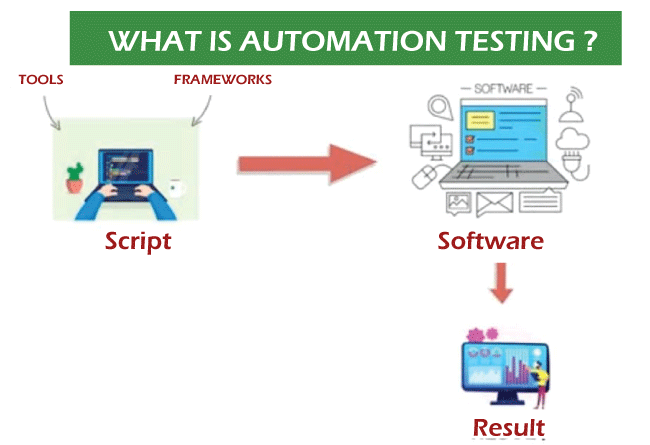Automation Testing: Trick Tips to Enhance Growth Lifecycles
Automation Testing: Trick Tips to Enhance Growth Lifecycles
Blog Article
From Handbook to Automated Screening: A Comprehensive Overview to Transitioning Efficiently and Effectively
In the world of software testing, the shift from handbook to automated processes has ended up being an increasingly vital transition for organizations seeking to improve performance and precision in their screening practices. As innovation remains to development, the demand for smooth and efficient computerized screening methods has never ever been much more pressing. The journey from guidebook to automated screening is not without its challenges, however when approached tactically and with a clear plan in mind, the advantages can be considerable - automation testing. In this extensive overview, we will certainly check out key steps and considerations crucial for a successful transition, from the initial selection of devices to the integration of automation right into existing operations. Keep tuned to discover the understandings that will certainly help pave the way for a smoother and extra effective screening process.
Benefits of Automated Checking
Automated testing supplies various advantages, boosting effectiveness and precision in software application growth processes. One primary benefit is the substantial decrease in testing time. Automated tests can be run simultaneously on numerous tools and operating systems, dramatically accelerating the testing phase contrasted to hands-on testing. This enhanced efficiency permits faster feedback on the top quality of the software program, making it possible for developers to determine and resolve concerns quickly.
In addition, automated screening makes certain a higher degree of precision in spotting flaws. Given that automated examinations follow predefined manuscripts, human mistake is decreased, causing even more trusted examination results. Uniformity in screening is additionally improved, as automated tests carry out the exact same actions precisely each time they are run. This consistency is essential in making certain that all capabilities of the software are extensively checked, lowering the chance of unseen insects sliding through to production.
Picking the Right Devices

First of all, analyze your goals and demands. Comprehend the scope of your task, the innovations entailed, and the skill set of your team. This analysis will certainly assist you identify the capabilities and functions you need in your screening devices.
Second of all, think about the compatibility of the devices with your existing procedures and systems. Seamless assimilation with your existing software application development lifecycle is vital to guarantee a smooth change to automation.
In addition, review the scalability and flexibility of the tools. As your testing requires progress, the tools ought to have the ability to adjust and accommodate adjustments successfully.
Last but not least, consider the support and area around the devices. When implementing automated screening, robust assistance and an energetic individual neighborhood can provide valuable resources and aid. By meticulously thinking about these aspects, you can choose the right devices that align with your demands and established the phase for an effective change to automated testing.
Writing Efficient Examination Scripts

When crafting examination manuscripts, it is important to think about the particular needs of the software application being checked and make sure that the scripts attend to all important functionalities. Clear and descriptive naming conventions for examination manuscripts and test instances can improve readability and maintainability. Additionally, integrating mistake handling mechanisms within the examination scripts can assist in identifying and attending to problems quickly.
In addition, organizing examination scripts right into modular parts can enhance reusability and scalability, decreasing redundancy and improving efficiency in test manuscript upkeep. Normal reviews and updates to check manuscripts are critical to keep speed with evolving software application needs and functionalities. By following these principles, testers can develop efficient and robust examination manuscripts that contribute significantly to the success of automated testing procedures.
Integrating Automation Into Workflows
Effective combination of automation devices right into existing operations enhances processes and improves productivity within software application growth cycles. When integrating automation into operations, it is important to recognize repetitive jobs that can be automated to conserve time and decrease human error. By seamlessly integrating automated testing tools like Selenium page or Appium right into the software application growth lifecycle, teams can achieve faster feedback on code adjustments, resulting in quicker pest detection and resolution. This combination permits for continual testing throughout the growth procedure, making sure that any problems are recognized beforehand, leading to greater software top quality. Furthermore, automation can be used to activate examinations immediately after each code commit, supplying prompt recognition and maximizing testers to concentrate on more complex situations. Correct integration of automation devices requires collaboration between growth, testing, and procedures teams to develop a unified operations that maximizes efficiency and effectiveness in providing top quality software.
Guaranteeing a Smooth Transition
Efficiently transitioning to automated testing includes precise preparation and careful implementation to lessen interruptions and make the most of efficiency in the software advancement process - automation testing. To ensure a smooth transition, it is necessary to begin by performing an extensive analysis of the current testing procedures and recognizing locations where automation can bring the most substantial advantages. Involving with all stakeholders beforehand while doing so, consisting of developers, testers, and job supervisors, is critical for gathering support and buy-in for the automation initiative
Communication is crucial during this transition phase. Clear interaction of the goals, benefits, and expectations of automated screening assists to manage any resistance or issues that might arise. Furthermore, providing sufficient training and resources for staff member to upskill in automation devices and techniques is crucial for guaranteeing a successful change.

Final Thought
In verdict, transitioning from handbook to automated testing offers various benefits, including raised performance and integrity. By selecting the suitable tools, composing efficient examination scripts, and incorporating automation seamlessly into process, companies can make certain a smooth and successful change. It is necessary to embrace automation as a valuable property in software application screening processes to enhance total high quality and efficiency.
In the world of software screening, the change from manual to automated procedures has actually become a significantly essential transition for companies seeking to enhance efficiency and precision in their testing methods. Automated examinations can be run at the same time on numerous tools and operating systems, considerably speeding up the screening phase contrasted to manual screening. Consistency in screening is likewise improved, as automated examinations execute the same actions specifically each time they are run.To make certain the successful execution of picked screening devices, the development of efficient examination scripts plays a vital role in confirming the functionality and performance of automated procedures - automation testing. By complying with these concepts, testers can produce robust and efficient examination manuscripts that add considerably to the success of automated screening processes
Report this page